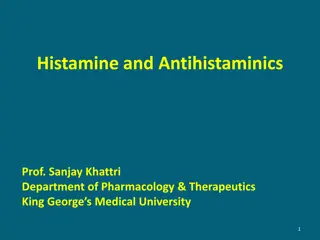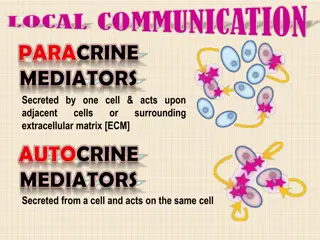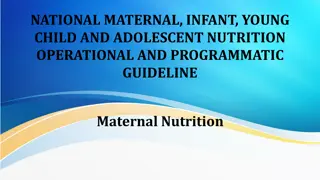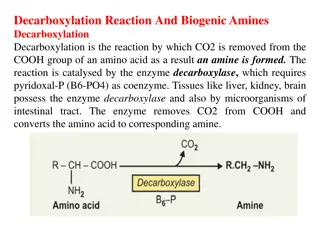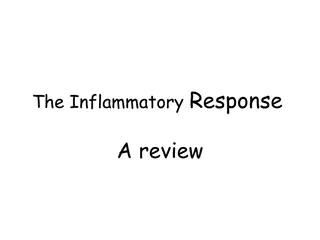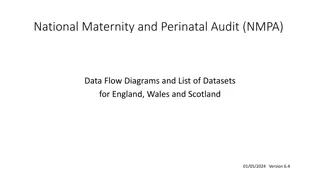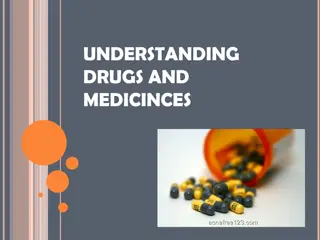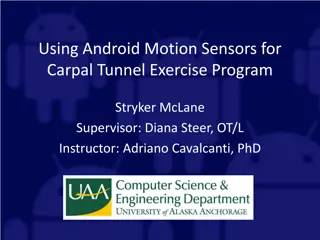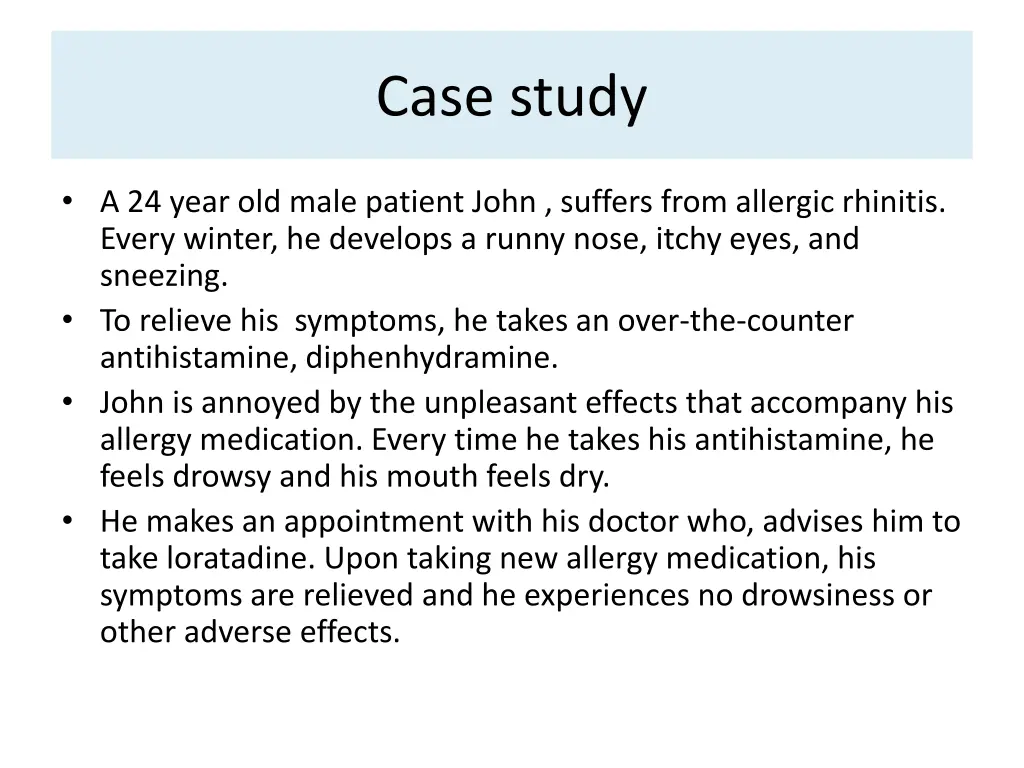
Understanding Histamine and Antihistamines in Allergic Rhinitis Treatment
Explore the pharmacology of histamine, the role of antihistamines in managing allergic rhinitis, and the differences between diphenhydramine and loratadine. Learn why certain antihistamines cause drowsiness while others do not.
Download Presentation

Please find below an Image/Link to download the presentation.
The content on the website is provided AS IS for your information and personal use only. It may not be sold, licensed, or shared on other websites without obtaining consent from the author. If you encounter any issues during the download, it is possible that the publisher has removed the file from their server.
You are allowed to download the files provided on this website for personal or commercial use, subject to the condition that they are used lawfully. All files are the property of their respective owners.
The content on the website is provided AS IS for your information and personal use only. It may not be sold, licensed, or shared on other websites without obtaining consent from the author.
E N D
Presentation Transcript
Case study A 24 year old male patient John , suffers from allergic rhinitis. Every winter, he develops a runny nose, itchy eyes, and sneezing. To relieve his symptoms, he takes an over-the-counter antihistamine, diphenhydramine. John is annoyed by the unpleasant effects that accompany his allergy medication. Every time he takes his antihistamine, he feels drowsy and his mouth feels dry. He makes an appointment with his doctor who, advises him to take loratadine. Upon taking new allergy medication, his symptoms are relieved and he experiences no drowsiness or other adverse effects.
Questions Why does John develop seasonal rhinitis? Why does diphenhydramine relieve John`s symptoms? Why does diphenhydramine cause drowsiness? Why doesn't loratadine cause drowsiness?
Autacoids (Histamine & Antihistamine) Prepared by Dr Rupinder Kaur Hashmi Conducted By Dr Naser Ashraf Tadvi 3
Objectives Describe the pharmacology of histamine & enumerate its related drugs. Classify the generation and sub-group of Histamine-1(H1) antagonists. Discuss the pharmacology of H1 Antihistaminics with emphasis on clinical uses, adverse drug reactions & interactions 4
Autacoids Autos = self; Akos = remedy (Greek). Secreted locally to increase or decrease the activity of nearby cells. Includes Histamine, Serotonin Prostaglandins and Leukotrines Cytokines 5
Histamine Histos: Tissue NH2 Present mostly in mast cells: skin, lungs, GIT Mucosa Non mast cell histamine: Brain, Gastric Mucosa 5 4 3 1 N N H 2 Histamine Histamine is a biogenic amine present in many animal and plant tissues .
Synthesis of histamine Synthesized by decarboxylation of amino acid histidine Histamine is present in storage granules of mast cells & also found in skin, lungs, liver, gastric mucosa etc. Synthesis occurs in same tissues in which histamine is stored. Stored in granules
Release 8
Mechanism of action Four types of receptors- H1 , H2, H3 and H4. All are seven transmembrane G-protein coupled receptors. Some wide actions are mediated by both (H1 and H2) receptors. 9
Mechanism of Action of Histamine Histamine H3 Receptors (presynaptic auto receptors) H1 Receptors H2 Receptors Ca2+ cAMP cAMP Smooth muscle contraction Increased capillary permeability Vasodilation Sensory nerve endings pain & itching Gastric acid secretion Blood vessels: vasodilation Increased capillary permeability histamine release secretion Vasodilation
Histamine receptor subtypes Receptor subtype Tissue distribution H1 Smooth muscle, vascular endothelium, brain H2 Gastric parietal cells, cardiac muscle, mast cells brain. H3 CNS and some peripheral nerves. H4 Hematopoietic cells, gastric mucosa. 11
Actions of histamine Tissues Effects Clinical manifestations Receptor subtype Lungs Bronchoconstriction Asthma-like symptoms H1 Vascular smooth muscle Post capillary venule dilation Terminal arteriole dialtion Venoconstriction Erythema H1 Vascular endothelium Contraction and separation of endothelial cells Edema, wheal response H1 Peripheral nerves Sensitization of afferent nerve terminals Itch, pain H1 12
Actions of histamine (contd.) Tissue Effects Clinical manifestations Receptor subtype Stomach Increased gastric acid secretion Peptic ulcer disease, heartburn H2 CNS Neurotransmitter Circadian rhythms, wakefulness H3 13
Drugs that cause release of histamine D-tubocurarine Morphine
Adverse effects of histamine release Itching, Urticaria Flushing Hypotension Tachycardia Bronchospasm Angioedema Wakefullness Increased acidity (Gastric acid secretion)
Antihistamines: H1 receptor blocker First generation Second generation 16
Therapeutic uses Allergic diseases Rhinitis, urticaria, conjunctivitis. Bronchial asthma Anaphylaxis Topical preparations- Levocabastine Azelastine Ketotifen Olopatadine 19
uses: First Generation Antihistamines Insomnia Anxiety Motion sickness Nausea and vomiting Morning sickness Vertigo 20
Uses: second Generation Antihistamines Allergies Reduce symptoms of itching, sneezing Rhinorrhea Allergic conjunctivitis 21
Common Adverse Effects Anticholinergic (Atropine-like) Blurred vision Dry mouth Tachycardia Urinary retention Dizziness Drowsiness Paradoxical excitement in infants and children Overdose of Astemizole and Terfenadine may cause arrhythmias 22
Contraindications Acute angle-closure glaucoma Hypersensitivity Urinary obstruction 24
Drug interactions Terfenadine and astemizole Ketoconazole Macrolide antibiotics Lethal ventricular arrhythmias. Torsades de pointes Withdrawn from market Grapefruit juice also inhibits CYP3A4. Increased levels of antihistamines. 25
Answers The IgE-mediated hypersensitivity reaction is responsible for initiation of certain inflammatory disorders, like allergic rhinitis . John suffered from allergic rhinitis, with a runny nose, itchy eyes, and sneezing. An environmental allergen, such as pollen, crosses the nasal epithelium and enters the underlying tissue. There, the allergen encounters previously sensitized mast cells and crosslinks IgE/Fc receptor complexes on the mast cell surface. The mast cell degranulates and releases histamine, which binds to H1 receptors in the nasal mucosa and local tissues.
Answers Stimulation of H1 receptors causes blood vessel dilation and es vascular permeability, leading to edema. This swelling in the nasal mucosa is responsible for the nasal congestion experienced in allergic rhinitis. The accompanying itching, sneezing, runny nose, etc result from the combined action of histamine and other inflammatory mediators, including kinins, prostaglandins etc. These molecules initiate the hypersecretion and irritation characteristic of allergic rhinitis.




